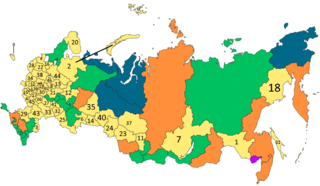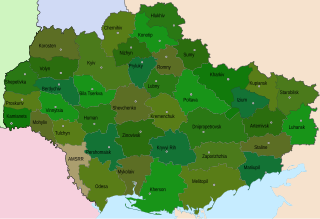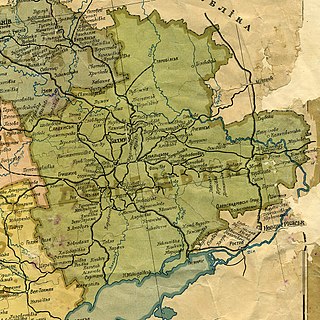
This is a list of historical regions in present-day Ukraine.

Donetsk Oblast, also referred to as Donechchyna (Донеччина), is an oblast in eastern Ukraine. It is Ukraine's most populous province, with around 4.1 million residents. Its administrative centre is Donetsk, though due to the ongoing Russo-Ukrainian War, the regional administration was moved to Kramatorsk. Historically, the region has been an important part of the Donbas region. From its creation in 1938 until November 1961, it bore the name Stalino Oblast as Donetsk was then named "Stalino". As part of the de-Stalinization process, it was renamed after the Siversky Donets river, the main artery of Eastern Ukraine. Its population is estimated as 4,100,280

Kharkiv Oblast, also referred to as Kharkivshchyna (Харківщина), is an oblast (province) in eastern Ukraine. The oblast borders Russia to the north, Luhansk Oblast to the east, Donetsk Oblast to the south-east, Dnipropetrovsk Oblast to the south-west, Poltava Oblast to the west and Sumy Oblast to the north-west. The area of the oblast is 31,400 square kilometres (12,100 sq mi), corresponding to 5.2% of the total territory of Ukraine.
A governorate, gubernia, province, or government, was a major and principal administrative subdivision of the Russian Empire. After the Bolshevik Revolution in 1917, governorates remained as subdivisions in Belarus, Russia, Ukraine, and in the Soviet Union from its formation until 1929. The term is also translated as government, governorate, or province. A governorate was headed by a governor, a word borrowed from Latin gubernator, in turn from Greek κυβερνήτης.

An oblast is a type of federal subject in Russia.

The administrative divisions of Ukraine are under the jurisdiction of the Ukrainian Constitution. Ukraine is a unitary state with three levels of administrative divisions: 27 regions, 136 raions and 1469 hromadas.

An oblast in Ukraine, sometimes translated as region or province, is the main type of first-level administrative division of the country. Ukraine's territory is divided into 24 oblasts, as well as one autonomous republic and two cities with special status. Ukraine is a unitary state, thus the oblasts do not have much legal scope of competence other than that which is established in the Ukrainian Constitution and by law. Articles 140–146 of Chapter XI of the constitution deal directly with local authorities and their competency.

The Taurida Governorate was a historical governorate of the Russian Empire. It included the Crimean Peninsula and the mainland between the lower Dnieper River and the coasts of the Black Sea and Sea of Azov. It was formed after the Taurida Oblast was abolished in 1802 in the course of Paul I's administrative reform of the territories of the former Crimean Khanate that was annexed by the Russian Empire in 1783. The governorate's centre was the city of Simferopol. The province was named after the ancient Greek name of Crimea - Taurida.

The Kherson Governorate was an administrative territorial unit of the Russian Empire located between the Dnieper and Dniester Rivers. It was one of three governorates created in 1802 when Novorossiya Governorate was abolished. It was known as the Mykolaiv or Nikolayev Governorate until 1803, when Nikolayev was separated into a special Nikolayev War Governorate as a center of the Black Sea Fleet and the governor seat was moved to Kherson.

The Yekaterinoslav Governorate, also known by Ukrainian common name Katerynoslavshchyna, was a governorate of the Russian Empire, with its capital located in Yekaterinoslav. The governorate covered 63,392 square kilometres (24,476 sq mi) of area, and was composed of the inhabitant of 2,113,674 by the census of 1897. The Yekaterinoslav Governorate bordered the Poltava Governorate to the north, the Don Host Oblast to the east, the Sea of Azov to the southeast, the Taurida Governorate to the south, and the Kherson Governorate to the east, and covered the area of the Luhansk, Donetsk, Dnipropetrovsk, and Zaporizhzhia Oblasts of Ukraine.

The Poltava Governorate or Poltavshchyna was a gubernia in the historical Left-bank Ukraine region of the Russian Empire. It was officially created in 1802 from the disbanded Malorossiya Governorate, which was split between the Chernigov Governorate and Poltava Governorate with an administrative center of Poltava.

The Kharkov Governorate was a governorate of the Russian Empire founded in 1835. It embraced the historical region of Sloboda Ukraine. From 1765 to 1780 and from 1796 to 1835 the governorate was called the Sloboda Ukraine Governorate. In 1780-1796 there existed the Kharkov Viceroyalty.

Novorossiya Governorate, was a governorate of the Russian Empire in the previously Ottoman and Cossack territories, that existed from 1764 until the 1783 administrative reform. It was created and governed according to the "Plan for the Colonization of New Russia Governorate" issued by the Russian Senate. It became the first region in Russia where Catherine the Great allowed foreign Jews to settle.

Administrative divisions development in Ukraine reviews the history of changes in the administrative divisions of Ukraine, in chronological order.

An okruha is an historical administrative division of the Ukrainian Soviet Socialist Republic that existed between 1923 and 1930. The system was intended as a transitional system between the Russian Imperial division of governorates and the modern equivalent of oblasts.
Censuses in Ukraine is a sporadic event that since 2001 has been conducted by the State Statistics Committee of Ukraine under the jurisdiction of the Government of Ukraine.

The administrative division of Ukraine in 1918 was inherited from the Russian Empire, and based on the largest unit of the gubernia with smaller subdivisions county or district, and rural district.

Donets Governorate was a governorate of the Ukrainian SSR (Ukraine) that existed between 1919 and 1925.

Novorossiya, literally "New Russia", is a historical name, used during the era of the Russian Empire for an administrative area that would later become the southern mainland of Ukraine: the region immediately north of the Black Sea and Crimea. The province fell largely within a slightly wider area known in Ukrainian as the Stepovyna "Steppe Land", or Nyz "Lower Land". The name Novorossiya entered official usage in 1764, after the Russian Empire conquered the Crimean Khanate, and annexed its territories, when Novorossiya Governorate was founded. Official usage of the name ceased after 1917, when the entire area was incorporated in the Ukrainian People's Republic.





















